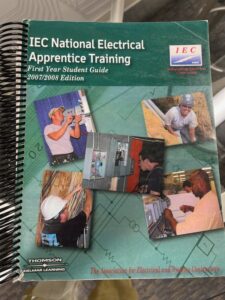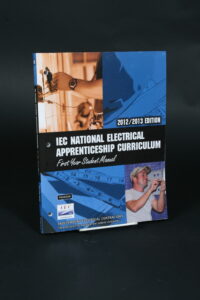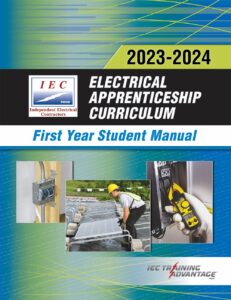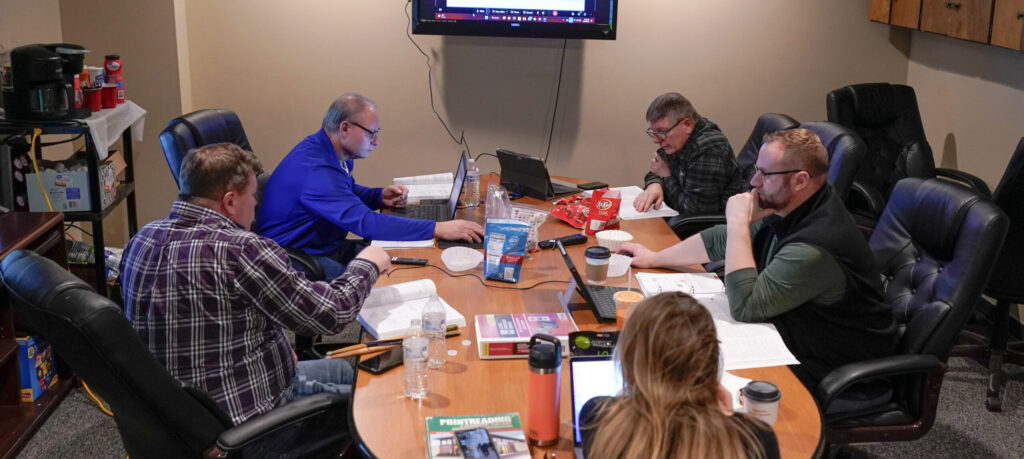A recent IEC Curriculum Development Group meeting.
Every fall updated editions of IEC National’s Four-Year Electrical Apprenticeship Curriculum are delivered to IEC chapters. The curriculum arrives in boxes neatly shrink-wrapped. The boxes are opened, and the curriculum distributed. Classes begin.
Ever wonder about the curriculum’s journey to the doorstep?
Its lengthy eight-month trek is filled with weeks away from home; long days and nights at numerous IEC chapters; extensive reading, writing, and editing; an abundance of laughing; and a great deal of candy and coffee.
The Team
I’m unsure if the universe could have brought together a better group of people to form the current Curriculum Development Group (CDG). They operate as one unit and have perfected their process. Current members include:
- Dale Weis, Executive Director, IEC Southern Colorado
- Ed Brown, Training Director, IEC Indy
- Ken Adams, Coordinating Director, IEC of Utah
- Kevin Collins, Training Director, IEC of Greater Cincinnati
- Raul Vasquez, Executive Director, IEC Indy
Each member is an electrician and has an affinity for a particular curriculum year, National Electrical Code® chapter, lesson topic, and industry trend. This is what makes the group function so well — the diversity of interests and passions.
Each member also brings an ‘ism’ to in-person meetings. These traits bring familiarity and comfort, which is especially nice when on the road.
- Dale finds the best breakfast spots and needs his water bottle full all the time.
- Ed needs coffee. Strong coffee. All the time.
- Ken requires Kit-Kats, preferably snack-sized, every day.
- Kevin brings noisemakers for sound effects — a squeaky dog toy, bike horn, and set of drumsticks — to reward us for completing a lesson.
- Raul needs coffee and room to pace.
- Though technically not a “member,” I need pistachios.
The Process
Initial discussions and planning begin in September via phone calls. CDG members and I schedule the next eight months. This involves selecting dates and locations to meet in-person and setting deadlines for content.
When meeting in-person, we go through each year of the curriculum page by page. Errata is addressed. Suggestions for improvement are discussed. Homework reading assignments are verified. During a Code update year, NEC® changes are made in conjunction with annual updates.
Over the last two years, Second and Third Years have been completely overhauled. During the most recent curriculum update cycle, the CDG reorganized the 2023-2024 Third Year and conducted NEC® updates for First through Fourth Years. It was not an easy task, but this group often burns the midnight oil. Passion does that to a person.
Our first in-person meeting is usually in late October or early November. During this meeting, a binder labeled “Chrissy’s Master Copy” is created and filled with red-lined and highlighted pages. Some pages are literally cut and taped together to form new lessons, which the CDG endearingly refers to as “Frankensteined” lessons. Through immense passion for the electrical trade, this binder will eventually morph into IEC’s exceptional Four-Year curriculum in eight wild months.
In December I start sending ATP, IEC’s publisher, edited manual files. (Workbook files are handled by another team, including a few CDG members.) Between December and February, there is a lot of back and forth between me and ATP. Lots of questions and lots of answers.
By March, it’s time to begin our first round of reviews. ATP provides updated PDFs from which we work. We generally meet in-person for these types of review sessions. PDFs are projected onto a screen, read through, and debated. I implement the CDG’s technical changes to the PDFs and then conduct an editorial review. It takes approximately two to three weeks to get edits from our in-person meeting to ATP. From there, weeks of back and forth ensue to ensure technical and editorial changes have been made. Between April and May, it’s cramming final edits, following up on outstanding items, and extending the workday to meet our May 1 deadline. At this point, we’re all questioning our sanity but not our commitment.
Once PDFs have been finalized, there is a page approval process conducted on my end with ATP. This process essentially “releases” pages for print. It’s the last step in the process — and a tedious one — but once that last page is approved, celebratory dances begin at IEC of Greater Cincinnati, IEC Indy, IEC Southern Colorado, IEC of Utah, ATP, and my home office. Eight months of teamwork is culminated by the final click of an “Approve” icon.
The Evolution
IEC’s Four-Year curriculum looks little like it did nearly 20 years ago, as you can see visually with the pictured representative cover designs. We also moved from spiral-bound to perfect bound for the student manual and binder format for the instructor manual. In addition, worksheets were removed from the student manual and now reside in a student workbook.
Information updates and improvements are made with each edition, such as:
- Moving updated printreading content from Third Year to Second Year
- Reorganizing Third Year
- Adding new topics and material to Fourth Year (to come in 2024-2025 school year)
- Creating three “levels” of hands-on activities to accommodate IEC chapters of varying sizes and resources
- Incorporating several indices into lessons to reduce back matter



The look of IEC curriculum has evolved and matured over the years.
The four-year curriculum hasn’t always carried with it 46 ACE-accredited college hours either. Every three years, the curriculum undergoes a detailed and thorough review by the American Council on Education (ACE). A small group of third-party subject matter experts spend more than a week assessing curriculum content, core concepts, labs, and hands-on activities. In 2013 ACE provided IEC graduates 37 transfer credit hours, but in 2021, ACE increased this to 46 credit hours. This is a direct result of the changes made over the last 10 years by the CDG, Apprenticeship and Training Committee, and contractor / chapter input. The next ACE review will occur in 2024.
The Future
Over the next several months, CDG members will meet to tackle the reorganization of Fourth Year. During that time, The Process will restart. Brand new content will be added, and lessons will be shifted. There will be travel, long days, in-depth discussions, and always (always!) a hearty breakfast. These factors, along with dedication and passion, are why the IEC curriculum remains at its finest year after year.


